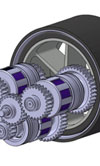KERS explained
 KINETIC ENERGY RECOVERY SYSTEM (KERS) EXPLAINED
KINETIC ENERGY RECOVERY SYSTEM (KERS) EXPLAINED
KERS is a collection of parts which takes some of the kinetic energy of a vehicle under deceleration, stores this energy and then releases this stored energy back into the drive train of the vehicle, providing a power boost to that vehicle. For the driver, it is like having two power sources at his disposal, one of the power sources is the engine while the other is the stored kinetic energy.
What is kinetic energy (KE)
Kinetic energy is the energy of motion. If a body is in motion it has kinetic energy but if a body is not moving, its kinetic energy is zero. Mathematically kinetic energy is defined as:

Where:
M = mass of the body in motion
V =linear velocity of the body
Normal brake operation
In general, to slow down a moving vehicle or bring it to a stop the friction brakes are pressed. The vehicle is decelerated by converting the kinetic energy of the vehicle into heat at the surface of the brakes which is then given up to the air flowing over the brakes. That is, there is a conversion of kinetic energy into heat energy, but in this process the heat energy is lost and is not recoverable.
Kinetic Energy recovery
The principle of how kinetic energy recovery works may be displayed by the following example: a vehicle is travelling along the road in 4th gear and to slow the vehicle down, the driver mistakenly selects 1st gear instead of 3rd gear. The result is that the front of the vehicle lunges downward under severe engine braking. The speed of the engine experiences a severe and quick run up, for example from 3000rpm to 6000rpm. This is the effect of kinetic energy being recovered from the forward motion of the vehicle, directed through the transmission and into the engine. In this example, the vehicle is slowed down quite aggressively.
This in principle is how KERS works under braking; except that on braking, the energy is transferred into the storage device and not into the engine.
There are three main types of KERS systems, these are: Mechanical; Electronic and Hydraulic. The mechanical system uses a flywheel to store the energy, the electronic system uses a battery to store the energy and the hydraulic system uses some form of fluid containment, to store the energy. Due to the size of fluid storage required, it is not expected that hydraulic KERS will be used in Formula One and it is therefore expected that only mechanical and electrical KERS will be developed for Formula One. Both of these systems store energy that would otherwise be lost when braking, allowing that energy instead to be re-used when accelerating.
Williams Hybrid Power has a flywheel system, however in this article we are looking at the mechanical system as designed by Flybrid.
There are three main parts to the flybrid system: a continuously variable transmission (CVT); a flywheel; and an electronic control unit (ECU). For Formula One, flybrid developed two versions of the system, one which had the system mounted behind the engine on top of the gearbox, and the other which had it mounted at the front of the engine on the crankshaft. When mounted on the gearbox, connectivity is via a fixed ratio gear connection as follows: a gear is attached on the output shaft of the flybrid unit, which meshes with a gear on the output shaft of the vehicles gearbox. It is expected that this fixed ratio gearing is external to the gearbox.
When gearbox mounted, the KERS unit is activated when the driver applies the brakes. At this time the ECU allows the gearbox output shaft to drive and energise the flybrid unit. When the driver needs the stored energy to add to the engine power output for additional acceleration, the driver presses a button on the steering wheel and the ECU allows the flybrid unit to drive the output shaft of the gearbox.
With mechanical KERS, it is possible to modulate the energy delivery from the flywheel in short bursts of one or two second duration, as well as, all at once. However, during wheel spin, no KERS power will be delivered.
An added benefit of KERS in Formula One, is that it can be used to brake later. In the same way that shifting gear from 4th to 1st in a road vehicle causes severe engine braking, so too does KERS have the same effect on a Formula One car during braking. Hence, KERS can provide an additional 80 horse power of braking.
Written by Eric Smart.